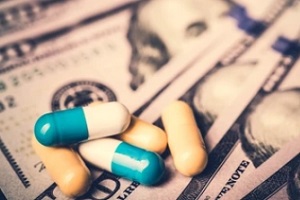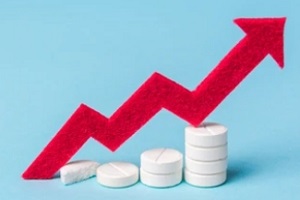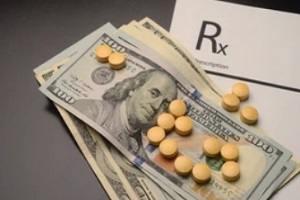 While many Americans raced to get the COVID-19 vaccine, many pharmaceutical companies increased the list prices of their name-brand prescription drugs. According to a recent article published by the Wall Street Journal, an increase in the month of January of 3.3 percent was slightly lower than the 5-plus percent rate that had been seen in recent years. However, this “smaller” increase in rates was applied to more than 50 percent more drugs than the previous increase.
While many Americans raced to get the COVID-19 vaccine, many pharmaceutical companies increased the list prices of their name-brand prescription drugs. According to a recent article published by the Wall Street Journal, an increase in the month of January of 3.3 percent was slightly lower than the 5-plus percent rate that had been seen in recent years. However, this “smaller” increase in rates was applied to more than 50 percent more drugs than the previous increase.
The cost of prescription drugs remains a major issue for Americans, according to KFF research, with three in ten respondents saying they have not taken their medication as prescribed due to cost. With the U.S. in the middle of a prescription drug spending catastrophe that threatens health systems’ ability to deliver the highest quality of care and patient access to care, solutions must be applied to rein in exorbitant prescription drug costs.
Why Prescription Drug Prices Are So High In The United States
There are currently no regulations that govern how drugs are priced in the U.S. Instead, pharmaceutical companies set the price of prescription drugs based on what they believe the market can bear. Prescription drug negotiations typically happen behind the scenes, leaving both physicians and patients out of the discussion despite the influence that drug pricing has on patient health and the healthcare system as a whole.
In other countries, such as Australia and Germany, prescription drug pricing is tied to the value that these drugs provide to patients in terms of efficiency or quality of life. This often makes these drugs more affordable to the patients that need them. In the United States, pharmaceutical companies that make and sell drugs are not obligated to explain pricing and argue that lowering the cost of prescription drugs could hinder innovation, resulting in fewer treatment options for patients.
The Current System Leaves Key Health Needs Unmet
Pharmaceutical companies are known to invest their research and development (R&D) dollars into medications and health conditions that are expected to be profitable, rather than drugs that are currently in high demand.
One example of prioritizing profits over patient needs relates to “me-too” drugs. These drugs are similar to existing drugs and make up a large percentage of essential medicines in the U.S.; however, they are not generic drugs and therefore do not come with the price reduction of generic medications. Instead, me-too drugs represent research that is primarily dedicated to boosting profits rather than patient outcomes.
 Today, more Americans have unmet health needs compared to two decades ago, according to a study published by the City University of New York at Hunter College and Harvard Medical School. The pandemic has exacerbated this problem as frequent shortages of critical medications, coupled with ongoing drug price increases, make it difficult for providers and hospitals to provide patients with much-needed care.
Today, more Americans have unmet health needs compared to two decades ago, according to a study published by the City University of New York at Hunter College and Harvard Medical School. The pandemic has exacerbated this problem as frequent shortages of critical medications, coupled with ongoing drug price increases, make it difficult for providers and hospitals to provide patients with much-needed care.
According to research sponsored by the Peter G. Peterson Foundation, healthcare expenditures in the U.S. greatly exceed those of other developed countries and are projected to increase at a significant rate but will generate substandard outcomes.
How The Pharmaceutical Industry Spends Its Profits
Pharmaceutical companies want consumers to believe that price hikes that consistently exceed inflation are necessary for continued drug research and development. However, further research reveals that R&D typically causes the net price of prescription drugs to decrease while most increases primarily benefit pharmacy benefit managers (PBMs).
PBMs are not directly involved in research and development and instead are responsible for managing prescription drug benefits on behalf of health insurers, large employers, Medicare Part D drug plans and other payers. They are paid large rebates to put drugs favorably on covered drug lists called formularies.
According to a recent report published by the House Oversight and Reform Committee, 14 of the biggest pharmaceutical companies in the United States spent $577 billion on dividends and stock buybacks from 2016 to 2020, a total of $56 billion more than what was spent on research and development. The report also revealed that out of the $521 billion spent on R&D, a “significant portion” of that spending was dedicated to suppressing generic competition by other drug companies. This is funding that could have been spent developing new drugs.
Pharmaceutical companies continue to receive significant U.S. government assistance in the form of tax breaks and publicly funded basic research, yet continue to charge unreasonable prices for prescription medications.
Pharmacy Benefits Managers’ Involvement
Pharmacy benefits managers operate in the middle of the prescription drug distribution chain. They are responsible for developing and maintaining formularies of covered medications on behalf of health insurers and directly contract with individual pharmacies for prescription drug reimbursements dispensed to beneficiaries. They also use their purchasing power to negotiate discounts and rebates from drug manufacturers.
There has been much controversy over the rebates that PBMs receive from drug companies. Many drug manufacturers argue that the growing number of rebates that they pay out to PBMs have forced them to increase list prices for their products. A report by Pew Charitable Trusts showed that manufacturer rebates to PBMs grew to $89.5 billion in 2016 from $39.7 billion back in 2012.
Pharmacy benefits managers have stated that they pass along a large share of the rebates to insurers; however, this can not be determined as rebates received are often not publicly disclosed. Many believe that if PBMs were to pass along a larger portion of these savings to health insurers and other payers, insurers could use these funds to help reduce cost-sharing payments and premiums.
What Solution Is There?
Rising prescription drug prices during the pandemic have become one of the biggest threats to the U.S. healthcare system but there is room for change. Policies to reduce prescription drug prices, limit out-of-pocket costs, and expand health insurance coverage could help many people access the prescription drugs that they are currently unable to afford.
 Switching to a value-based pricing system is key to better serving patients and improving the overall efficiency of health care spending in the U.S. Value-based pricing is based on the concept of paying for drugs in proportion to the benefits that they provide to patients over other existing drug options. In other words, instead of allowing pharmaceutical companies to charge whatever price they want to maximize their profits, a value-based framework ties drug price to the extent to which a drug could help patients more than current treatment options.
Switching to a value-based pricing system is key to better serving patients and improving the overall efficiency of health care spending in the U.S. Value-based pricing is based on the concept of paying for drugs in proportion to the benefits that they provide to patients over other existing drug options. In other words, instead of allowing pharmaceutical companies to charge whatever price they want to maximize their profits, a value-based framework ties drug price to the extent to which a drug could help patients more than current treatment options.
Value-based pricing could potentially affect lower health care spending in the healthcare system, change the health conditions in which the pharmaceutical industry currently invests research funds and drive better patient outcomes. There are several ways in which value-based pricing can be leveraged to achieve these objectives, such as by advancing health equity, promoting research into underinvested health conditions and minimizing spending on drugs that do not have a proven benefit.
Learn More From New City
The pandemic has forced change in nearly every industry but few as much as pharmaceuticals. Prescription drug prices remain too high in the U.S. and these exorbitant prices are often driven by financial incentives. Lowering healthcare costs is more important now than ever before. Reach out to the knowledgeable employee benefits consultants today at New City Insurance to learn more or to request a consultation.
